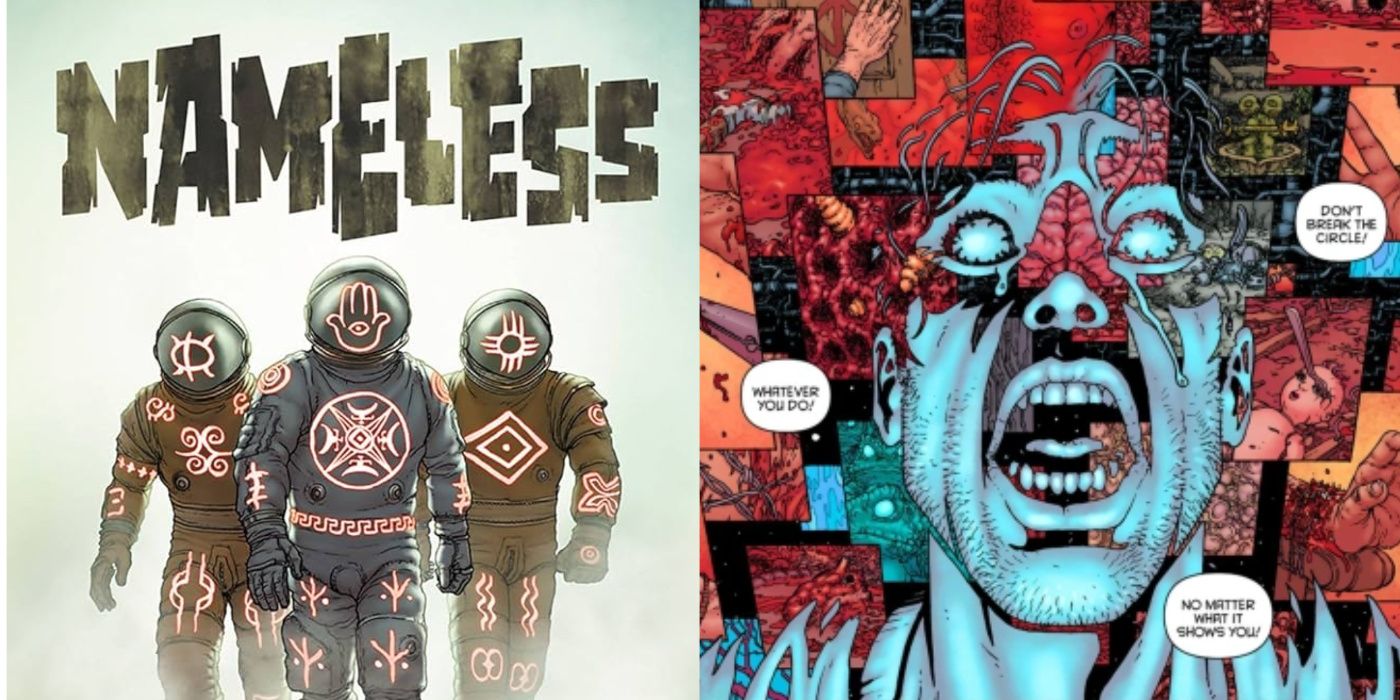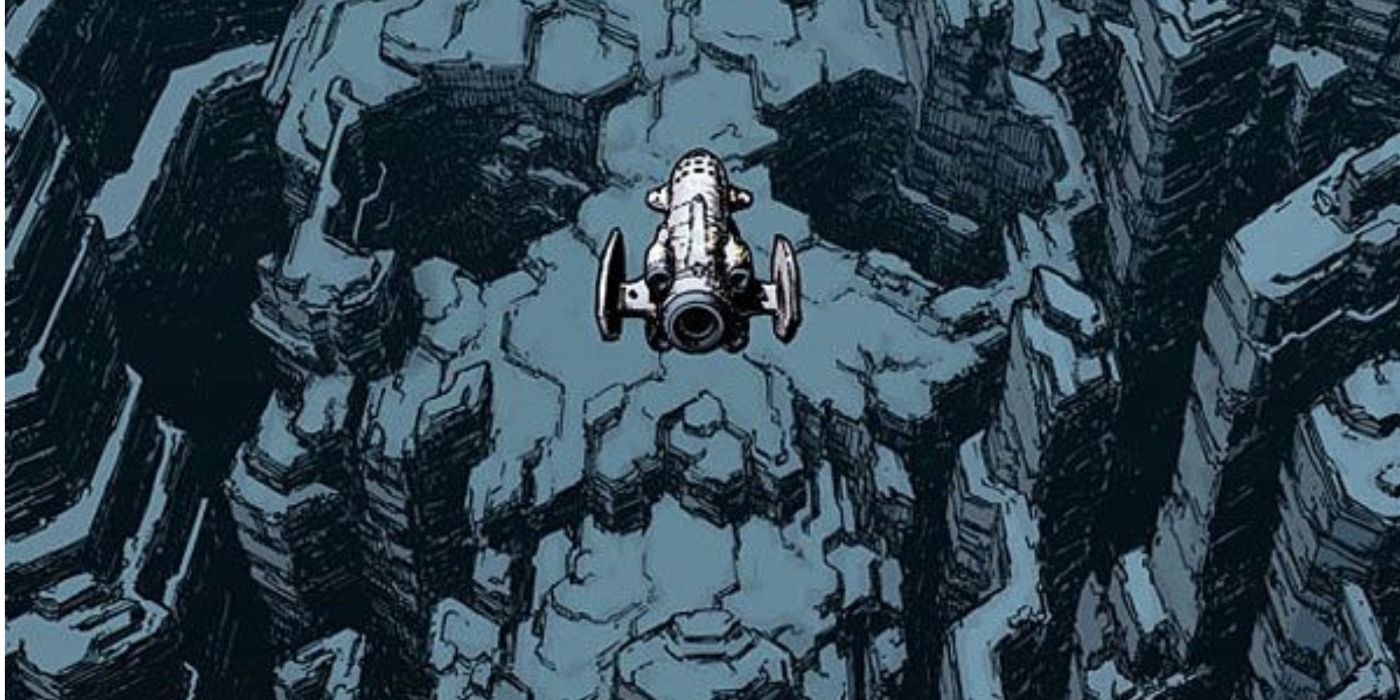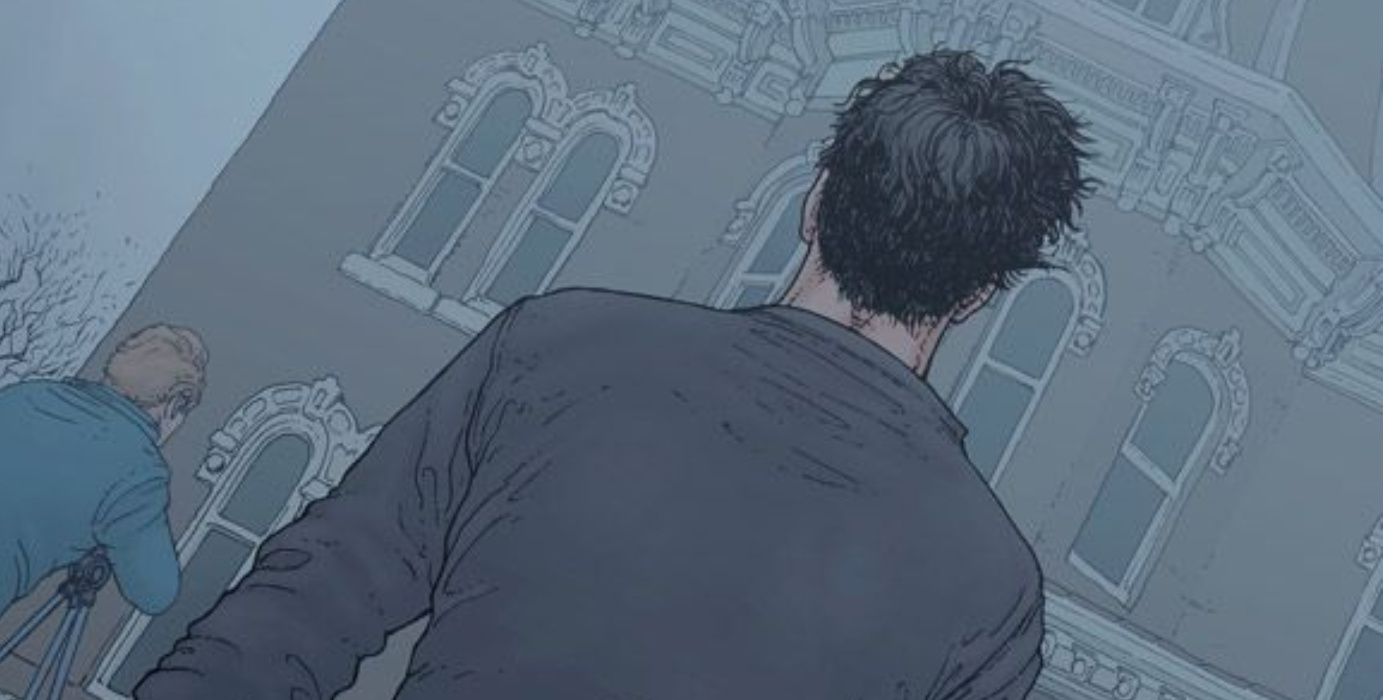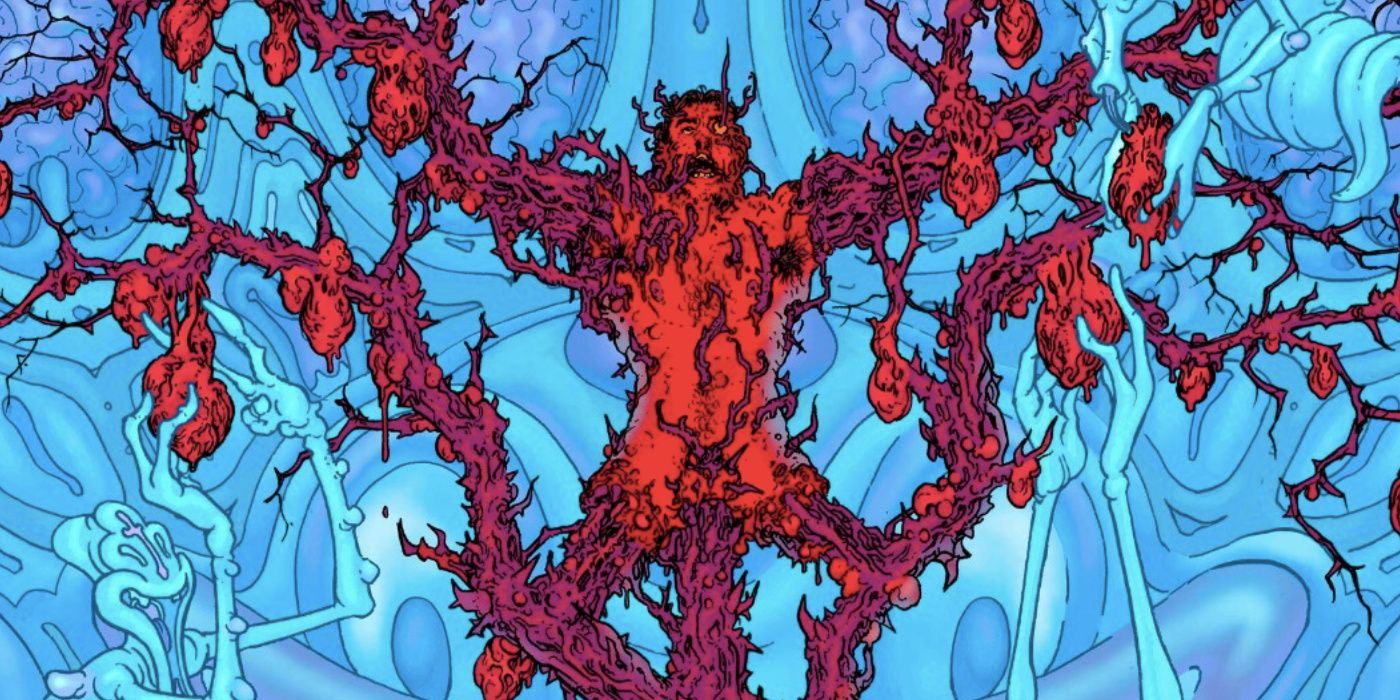Summary
- Grant Morrison's "Nameless" is a cosmic horror epic that showcases why comics are a great medium for this genre.
- Morrison's blasphemous take on God as a cosmic horror figure challenges traditional religious beliefs.
- Chris Burnham's detailed and eerie artwork brings the horrifying and fantastical elements of "Nameless" to life.
This article is part of CBR's 31 Days of Halloween Event. Read the rest here!
Grant Morrison is a well-known name in comics, thanks to their boundless imagination and ability to find brilliant new takes on classic characters. Readers often associate Morrison with comics like JLA, New X-Men, Batman, Doom Patrol, Animal Man, or one of their many mainstream superhero books. However, Morrison has always worked on creator-owned books, many of which fall into the horror genre.
The Invisibles and The Filth both had a feeling of Lovecraftian cosmic horror to them, but both of them pale in comparison to Nameless, a cosmic horror epic published by Image Comics. Morrison, working with Chris Burnham, Nathan Fairbarn, and Simon Bowland, created a chilling comic that bends readers minds while enmeshing them in a story that is thought provokingly blasphemous. Nameless is cosmic horror at its finest and shows why comics are such a great place for that kind of story.
What's In A Name?
Grant Morrison loves the comic medium. While they've basically worked in every kind of storytelling medium under the sun, Morrison always comes back to comics. They have an understanding of how to use the comic page to get across the ideas they want to that is almost unparalleled. Morrison works well with artists, and that's helped make their work something special. Morrison has a few favorites they worked with more than others, and Chris Burnham is one of them. Burnham and Morrison worked together on Batman And Robin and Batman Inc. Burnham's style is reminiscent of Morrison frequent collaborator Frank Quitely, but with an eye of detail that makes his work unique.
Burnham actually came up with idea for Nameless, as revealed in an appendix section in the back of the collected edition. Burnham wanted to draw a six-issue book about monsters in space and Morrison wanted to do something that was more occult influenced and magical. Morrison decided that the best way to make both of them happy was to go Lovecraftian with the whole thing. That was the genesis of the idea for Nameless. Sci-fi comics are a vital genre, and the duo went to Image, a publisher that has been putting out many of the greatest sci-fi comics of the 21st century. The stage was set for a very different kind of comic, one that would twist readers minds in directions that no one would guess at from the beginning.
The Darkness Between The Stars
Nameless follows the titular character, an occult detective/mercenary who is recruited for a space mission to save the Earth. Xibalba, a massive asteroid named after the Mayan underworld, was coming to Earth, a remnant of the destroyed fifth planet in the solar system and home to a primordial terror. That's a pretty amazing set-up, and shows why Nameless would make an excellent movie. However, that's only the beginning. Nameless takes readers on a ride, revealing that not everything is as readers imagine. The story loops around several times, as readers realize just what Xibalba is and what it carries toward Earth: God.
Nameless's big twist isn't just that so much of the story isn't actually real, all taking place as a manipulation of Nameless, but that its cosmic horror is centered on God. It's an interesting idea that Morrison gets into in the appendix at the back of the collected edition. While Morrison set out to create something Lovecraftian, they didn't do what many others have done and just copy Lovecraft completely. Instead, Morrison makes the leap that any entity that would create an eternal concentration camp for people that didn't worship them and created a billion little ways to kill their creations is the ultimate cosmic horror god. Sure, Cthulhu has his monstrous followers, but God's followers have caused much more suffering, while God grows fat and affluent on the prayers and atrocities committed in its name.
Morrison is no stranger to ideas that are blasphemous. Morrison's masterworks like The Invisibles center on a secular world that was created by the intersection of two universes, one of complete and terrible order and the other of beautiful chaos. The villains of The Invisibles are the Archons of the Outer Church, and the Outer Church uses religious imagery often. Morrison's work has always been rather cynical when it comes to organized religious practices of any kind, and Nameless is another example of this. However, the great thing about Nameless isn't that Morrison is being visibly blasphemous for shock value. In Nameless, God isn't any given church or religion. Morrison never attacks the believers of any religious belief system. Nameless is more against the concept of God as practiced by many out there. Nameless reveals the secret history of the solar system and doesn't see God as a creator, but more as an immensely powerful being that lost a war against the inhabitants of a planet that destroyed itself to imprison this God.
Nameless's God is a poisonous idea, a meme that will spread through humanity, causing suffering and death. The story's loop - with Nameless realizing exactly what he's been fighting and what the last decade of his life really was - lulls readers into a false sense of security. It starts out as one thing - a rather simplistic story that feels like Armageddon if the Earth-killing asteroid was magic - and then completely flips things on readers. Events that are referenced as part of the past take on entirely new significance as the truth of Nameless unfolds. Grant Morrison is known for their big ideas, and Nameless plays off that very well. As a primordial God approaches Earth, human magic is able to defeat it and confound it, humanity fighting back against the poisonous thought form that has victimized the species for much of its existence. This exactly the kind of story that Morrison fans expect, a story that works on multiple levels and is humanist at its core. Many of Morrison's biggest stories are about humanity saving itself from the worst threats and that's what Nameless does as well, as a character that no one expected is able to stop God's infection and save the Earth.
Rendering Unknowable Terror
Nameless isn't just a philosophical treatise on God and humanity's place in the universe. It's also a comic with brilliant art. Chris Burnham's idea for a space monster comic was the beginning of Nameless and the artist truly knocks the book's art out of the park. From the first page, readers can see this is going to be a beautiful comic. The first page teases events from the future of the book's recursive time loop, four impeccably drawn and colored panels over a background that eventually turns into a gaggle of toads at the bottom of the page. It's an unnerving first page, not because of the captions or the writing, but because Burnham and Fairbairns understand exactly what kind of book this is going to be and their art shows that.
Cosmic horror has to mix the rational and the supernatural very well to work, something that in comics come down to how the art is rendered. Burnham's pencils are all about the detail and that really helps ground readers in what's happening on the page. The first issue is all set-up, as Nameless first accomplishes his mission of trying to steal what is basically the key to the Veiled Woman's thoughts, and then is taken to join the space mission to stop Xibalba. Burnham and Fairbairn are on fire throughout. The detailed, gritty pencils and surprisingly bright color palette work as well for the parts of the issue that have to do with the magic and the more grounded ones that set up the space mission plot. It's a visual treat, something that Burnham and Fairbairn keep up throughout the rest of the book.
The art in Nameless really needs to be seen to be believed. The detail that Burnham imbues into Xibalba, this massive ominous structure, will set the hair on readers' necks to attention. This massive shard of a planet is the ultimate prison, something that Burnham and Fairbairns get across through their use of pencil, ink, and colors to render its brutalist design. The collected edition show the mind-numbing detail of Xibalba with some uncolored pages that show just how much work Burnham put into rendering it and how much Fairbairn's colors do to bring the imagery to life.
Burnham and Fairbairns also do a tremendous job with the gore in this book. Nameless isn't something like Crossed, which glories in the atrocities on its every page, but there are a lot of blood and organs strewn about the book. Burnham's style is perfect for this sort of thing. There are scenes in this comic that will stand out for readers, like the one that shows a vivisected Nameless missing all five of his appendages - that's right five - with the head of Sofia, possibly the most important character in the story, in front of him. There are scenes or horrific violence throughout this book - gruesome murders committed under the influence of God - and they are gorgeously rendered. However, there are also some pages that full of wonder, especially those that show the battles between God and the inhabitants of the destroyed fifth planet.
That's the glory of the art of Nameless. Burnham and Fairbairns are able to repulse and entice readers with every page. There are scenes, like an early one of a street full of humans committing horrendous acts, that will scar a reader's mind. And then there are others, like the ones that reveal the truth about the entity inside Xibalba, that are both horrific in the tortures they exhibit, but also strangely alluring. The amount of detail that goes into every page of the book is amazing and what makes the horror hit home. Nameless is a wonderful mixture of idea and art. The ideas give the art life and vice versa. As important as Morrison's knowledge of the occult is to the book - the appendix in the back of the collected edition talks about all of Morrison's occult and philosophical inspirations for the book - Nameless wouldn't exist without Burnham's germ of an idea and the mind-blowing art. Nameless isn't just spooky; it's a deep and terrifying ride through ideas about humanity and the divine, and without the excellent art, the ride just wouldn't be the same.
The Power Of Being Nameless
Grant Morrison loves to write philosophical comics, and Nameless is a great example of their modern work. Morrison wanted to tell a story that mixed magic, the occult, and pessimistic philosophy for a story about humanity triumphing through the power of women, creating a bold new aeon. Nameless came out in 2015, around the same time Morrison was working on the very feminist Wonder Woman: Earth One graphic novels, so they were very interested in stories about the power of women. Nameless is able to do so many things, which is the main reason it's such a great read. Morrison uses Nameless as a vehicle to talk about things they've always been interested in, giving readers an interesting story that will send their mind in so many directions.
An artist can seem unimportant in a book like Nameless, which at its core deals with the way religion has affected humanity, but this book wouldn't exist without Chris Burnham. His idea was the beginning of the whole thing, and his art is grotesquely beautiful. The book's ideas wouldn't exist without him and his art; even if Morrison wrote a similar story for another artist, they could never bring to the table what Burnham did. The symbiosis between creators is an important part of comics and one reason why the medium creates such amazing stories - it's a collaborative medium like no other. Nameless exists because two amazing creators were able to work off each other, each one a storehouse of ideas that bring the book's concept to life. Nameless shows just what kind of horror two brilliant creators can create when they work together. Nameless came from humble origins (Burnham just wanted to draw some space monsters) and became an unforgettable horror comic.







